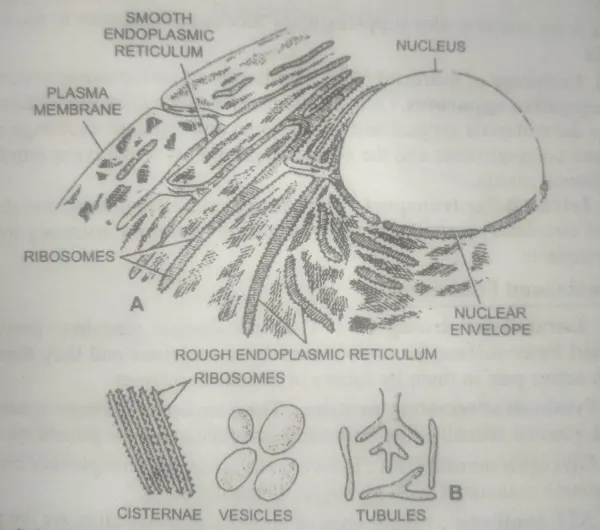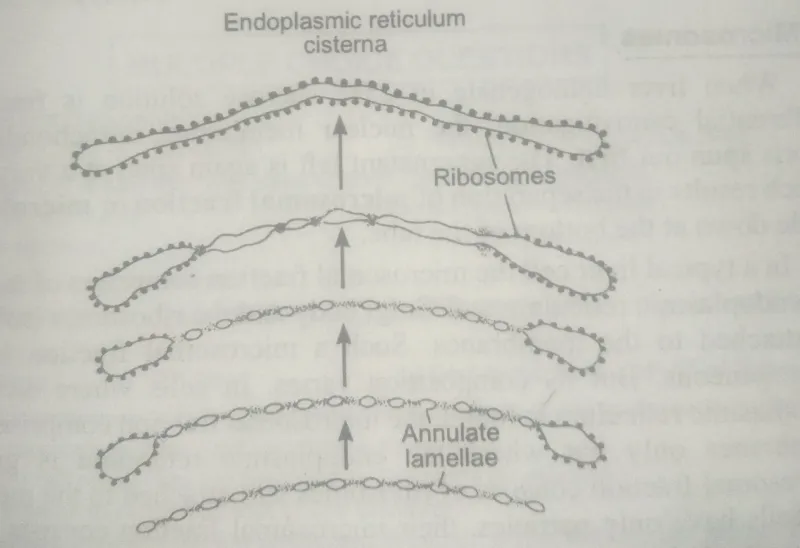Hello, guys. In today’s article, we will study the Endoplasmic reticulum. Like – what is the endoplasmic reticulum? What is a rough endoplasmic reticulum? We will know the answers to many such questions today, so let’s start.
What is the Endoplasmic reticulum?
Endoplasmic reticulum definition –
The endoplasmic reticulum (ER) is a network-like structure of flattened tubes and sacs inside eukaryotic cells‘ cytoplasm. It plays an important role in synthesizing proteins and lipids.
Who discovered the endoplasmic reticulum?
Endoplasmic reticulum, discovered by Keith Porter.
Ultrastructure of Endoplasmic reticulum
The endoplasmic reticulum forms an elaborate system of flattened tubules or channels in the cells’ ground substance. The channels are bounded by membranes with the same basic structure as the plasma membrane.
In some cases, these extend from the cell membrane to the outer nuclear membrane, establishing a continuous system of channels from the external environment to the nucleus.
The endoplasmic reticulum comprises three different components.
Vesicles are almost rounded spherical or ovoidal spaces measuring 25 to 500 microns.
Cisternae are long and flattened lamellar vesicles about 40–60 microns thick and usually disposed of in parallel Rows surrounding the nucleus in the forms of successive layers. Tubules – They are in the form of irregularly branched tubules having a diameter of about 50–100 microns. These are most common in the cells that carry the synthesis of steroids and in the pigmented epithelial cells of the retina.
Endoplasmic reticulum diagram

Types of Endoplasmic reticulum
Two types of Endoplasmic Reticulum are found:
- Agranular or smooth endoplasmic reticulum (SER)
- Granular or rough endoplasmic reticulum (RER)
What is a smooth endoplasmic reticulum?
Agranular or smooth endoplasmic reticulum (SER) – The membranes of this type of reticulum are without ribosomes. Smooth endoplasmic reticulum occurs in cells that do not synthesize protein, such as adipose cells, glycogen storing, and muscle cells.
What is a rough endoplasmic reticulum?
Granular or rough endoplasmic reticulum (RER) – The rough endoplasmic reticulum membranes are deposited with ribosomes. The smooth endoplasmic reticulum is found in all those cells that play an active role in protein synthesis.
What is the function of the endoplasmic reticulum?
Common functions of endoplasmic reticulum
Mechanical functions – The endoplasmic reticulum forms a skeletal Framework and Provides supplementary mechanical support to the colloidal matrix.
Exchange of material—The membranes of the Endoplasmic reticulum act as a segregation apparatus, maintaining Osmotic pressure within the cell. They isolate the material synthesized for delivery and regulate exchange between the inner and outer compartments or the compartments and cytoplasmic matrix.
Intracellular transport – The endoplasmic reticulum acts as a circulatory system for transporting various substances inside the cell cytoplasm.
Specialized functions of Endoplasmic reticulum
Intracellular transport – The endoplasmic reticulum provides an increased Inner surface for various metabolic reactions, and they take an active part in them using attached enzymes.
Synthesis of secretory proteins – The microsome function attached to the endoplasmic reticulum is intimately associated with protein synthesis.
Glycogen metabolism – The agranular endoplasmic reticulum is intimately associated with glycogen metabolism in liver cells.
ATP synthesis – Membranes of the Endoplasmic reticulum are the site of ATP synthesis in the cell. ATP is an energy source for all the intracellular metabolism and transport of material.
Formation of other cytomembranes – The endoplasmic reticulum forms other membranous structures of cell-like mitochondria and Golgi bodies.
Transport of message from genetic material—It also provides passage through various RNA from the genetic materials to pass from the nucleus to the different organelles in the cytoplasm, thus controlling the synthesis of proteins, fats, and carbohydrates.
What is annulate lamellae?
Usually, the endoplasmic reticulum membranes are continuous without any pores and pore complexes. However, some Endoplasmic reticulum membranes in some cells possess pores and pore complexes.
These represent and annulate lamellae. These were first described by McCulloch (1952).
The annulate lamellae are found in the cells of invertebrates in the immature oocytes, spermatocytes of vertebrates, and embryonic fetal cells, which have a high rate of metabolism.

Annulate lamellae are double membrane sheets. About 2–12 lamellae are arranged to form stacks. Structurally, These are similar to the nuclear membrane. It is evidence that annulate lamellae arise from the nuclear membrane.
The outer membrane of the nuclear envelope forms finger-like processes, which are pinched off into the cytoplasm as vesicles called blebs. This process is known as blebbing. The vesicles migrate in rows towards the Peripheral of the cells and fuse to form cisternae..
What is a Microsome?
The nuclear membrane mitochondria and cell debris spun out first when the liver homogenated in 25M fractionated by differential centrifugation.
The supernatant left is spun at a very high speed, separating microsomal Fraction or microsome, which settles at the bottom of the tube.
In a typical liver cell, the microsomal Fraction comprises the membranes of the endoplasmic reticulum and Golgi body, and the ribosome is isolated and attached to these membranes. This microsomal fraction is known as heterogeneous.
But its composition varies. In cells with only agranular endoplasmic reticulum, the microsomal Fraction comprises smooth membranes only. However, where the endoplasmic reticulum is granular, The microsomal Fraction consists of ribosomes still attached to the membranes.
If the cells have only particles, their microsomal Fraction consists of particles (ribosome) alone.
Microsomes constitute about 15- 20% of the cell’s total mass. They comprise 50-60% RNA, a few lipids, and many enzymes. The enzymes are NADPH—cytochrome C reductase, NADPH diphosphatase, glucose—phosphatase, Mg++-activated ATPase, and UDP (uridine diphosphatase).
You will get the answers to all the questions in the article below.
- What is the main function of the endoplasmic reticulum?
- What is endoplasmic reticulum, in simple words?
- What is the function of the endoplasmic reticulum and its types?
- Why is it called endoplasmic reticulum?
- What is the definition of RER and SER?
- What is the difference between rough ER and smooth ER?
- Who discovered the endoplasmic reticulum?
Conclusion
So, friends, in today’s article, we studied what the endoplasmic reticulum is. Friends, if you like this article, please comment and explain your suggestions and our mistakes.
Thank you